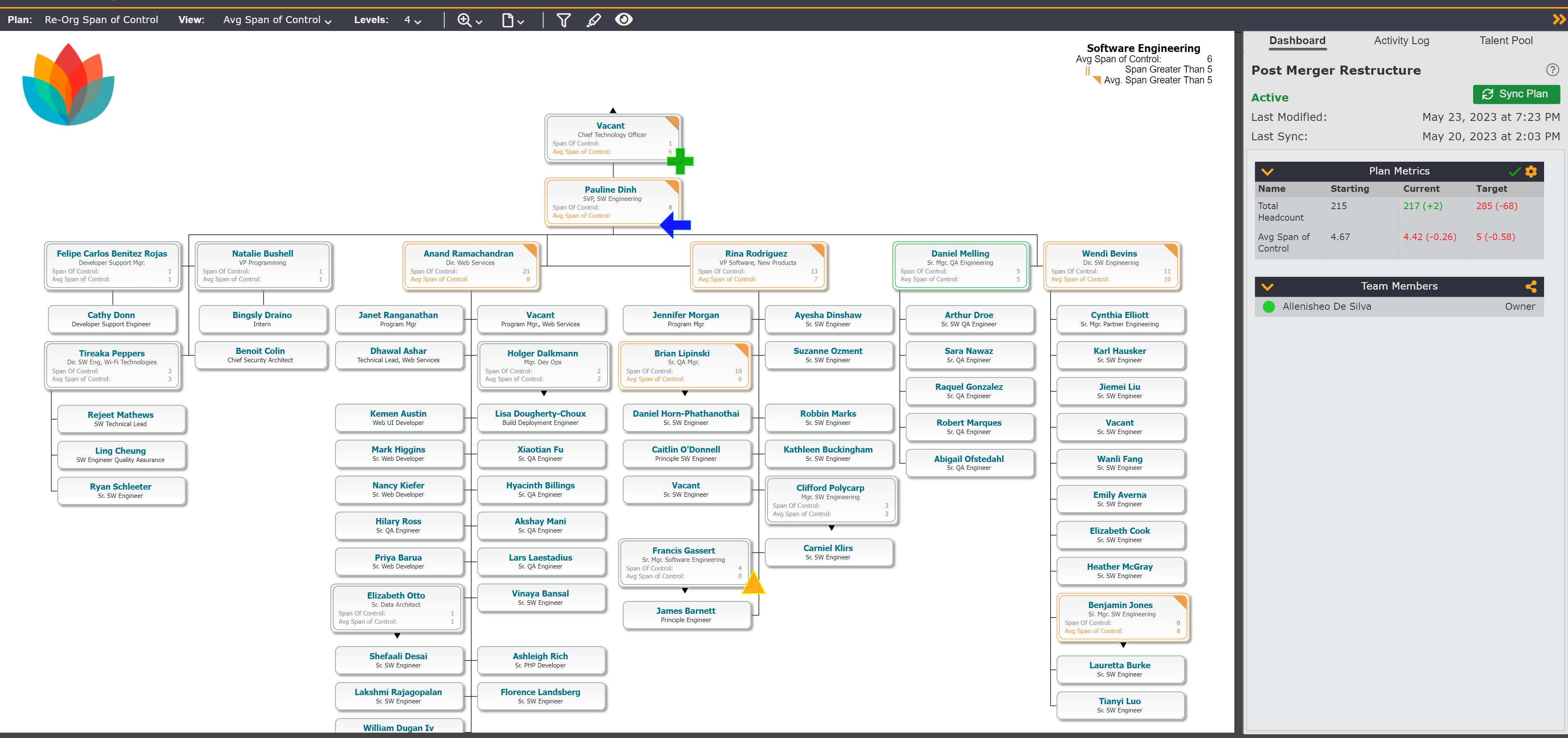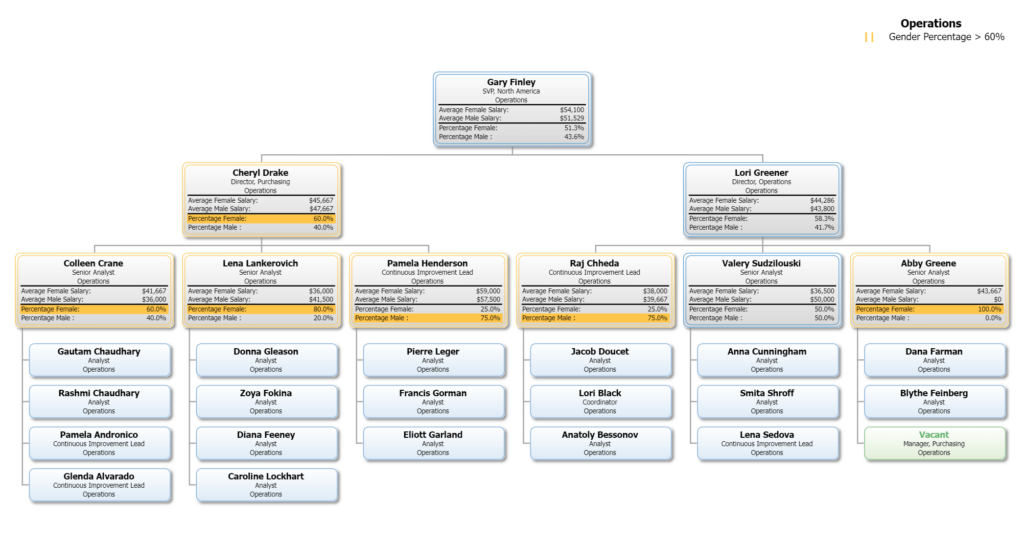May 23, 2023
8:20 PM

During organizational restructuring, mergers, downsizing, rightsizing, or navigating through a recession, stakeholders must collaborate to make tough decisions and find optimal solutions. Aligning business priorities and finding timely answers to critical questions is essential for successful transitions. Our economic landscape is ever-changing, often transitioning into a recessionary period before it’s widely recognized. As per Ryan Sweet, director of real-time economics for Moody’s Analytics, “The economy can be in a recession before the recession is widely recognized as having begun.”
The necessity for organizational adaptation is a reality, says Joyce Chastain, SHRM-SCP, president of Chastain Consulting, who puts it simply, “Organizations must periodically rightsize.” Never is that more true than in the face of economic uncertainty.
OrgChart, a leading org chart software, can expedite stakeholder collaboration amid workforce planning exercises by providing an intuitive way to visualize workforce structure and communicate proposed models during these crucial periods. Efficient planning is critical, and our automated charts offer an essential part of the framework that better envisages the future. OrgChart provides an invaluable tool in such situations, allowing seamless data consolidation, custom metrics, and a canvas to model various hypothetical scenarios to manage to rightsize effectively.
Request a Demo
Here’s a simple three-step process for managing re-orgs, downsizing, rightsizing, and mergers in challenging economic times.
Comprehensive analysis of the future workforce is crucial in any form of organizational restructuring, including downsizing or rightsizing during a recession. This analysis requires data from all relevant sources to be combined. OrgChart integrates data from your HR and applicant tracking systems, allowing you to review and compare organizational structures from a single, automated organizational chart.
Implementing fair and equitable decision-making processes during a RIF is critical. As Gerald Hathaway, an attorney with Drinker Biddle in New York City, emphasizes, “An employer’s choice of selection criteria to determine who will be laid off is the most critical decision made in the course of a RIF.”
OrgChart helps to ensure your organization’s decisions are backed by data, strengthening the objectivity and defensibility of your restructuring process.
OrgChart provides a visual interface that helps HR professionals identify crucial data points to inform these critical decisions. The establishment of objective selection criteria in downsizing or rightsizing scenarios is paramount. Molly Batsch, an attorney with Greensfelder, states, “The more objective the selection criteria, the more defensible they are if later challenged in court.”
Once the key variables have been identified, you can create and test new organizational structures. OrgChart’s Collaborative Planning module allows you to shift personnel into different groups and compute the effects of these changes in real time. This capability is especially critical when strategizing for downsizing or rightsizing during a recession.

The end goal of any RIF should be preserved in the process of its implementation. David Froiland, an attorney with Ogletree Deakins, suggests, “Ideally, the selection criteria should reflect factors that will be most important to the ongoing business after the RIF is implemented.”
With OrgChart, you can model multiple scenarios, considering key factors relevant to your organization’s future. This way, you ensure that your planning aligns with your long-term business objectives, even amidst challenging times. The best part? Your planning scenarios stay private, and are only available to the stakeholders who need them.
A clear visualization of the organizational structures involved, combined with a robust tool to manipulate employee data, enhances the speed of integration and increases the likelihood of successful outcomes, even amid a recession.
Analyze your workforce by importing data from multiple HRIS sources, enabling you to seamlessly review and compare organizational structures.
Effortlessly restructure org charts in real-time with key stakeholders using our intuitive drag-and-drop tools for dynamic data presentations. This feature allows for a more objective selection process during layoffs, aligning with Kelly Scott’s, an attorney with Ervin Cohen & Jessup’s statement, “Most employers prefer performance-based layoffs, as they like to keep the best workers. This isn’t always possible if a company hasn’t kept proper records. If documentation is inadequate, forced ranking is typically done.”
Securely create plans and communicate them to audiences at the right time, ensuring data privacy and security. These measures allow HR leaders to keep workers apprised of company finances to the extent possible.
Incorporate a dynamic range of HR metrics into your charts, including competencies, the span of control, diversity markers, and budget roll-ups, to provide a comprehensive view of your organization. This breadth of data highlights potential issues and areas for improvement. As Steve Wolfe, executive vice president of operations at Addison Group, states, “The laid-off workers might feel that using seniority as a basis for choosing whom to lay off is unfair.” Workforce analytics can ensure your organization is fair and balanced in its restructuring decisions.

Model hypothetical scenarios based on key variables, refine and compare them to explore “what if” possibilities, and plan for different future states of your organization. By doing so, you echo Froiland’s recommendation: “The selection criteria should reflect factors that will be most important to the ongoing business after the RIF is implemented.”
Allen Smith, J.D., “How to Make Layoff Decisions Fairly and Minimize Litigation Risks,” SHRM, November 12, 2019. https://www.shrm.org/resourcesandtools/legal-and-compliance/employment-law/pages/layoffs-selection-criteria.aspx
Tags: